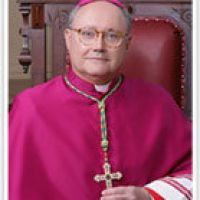There are some interesting to watch for in the upcoming Christmas time Papal Liturgies. This is a translation of article from the Italian paper which is located on this thread. Many of these can be seen on EWTN
Novelties as well as continuity with tradition will mark the Papal liturgies this season
By ROMA MIMMO MUOLO
Continuity with tradition and with the Council, a language of signs, but above all, careful attention to creating an atmosphere of meditation and prayer which should characterize all liturgical celebrations. These are the principal criteria which, at Pope Benedict's wishes, the Office for Pontifical Liturgical Celebrations is following in preparing the solemn liturgies for the Christmas season and for the Pope in general.
There are quite a few novelties this year which are significant. Among this, the fact that on Christmas Day, the figurine of Baby Jesus will be laid on the small 'throne' used during Vatican-II to hold the Gospel. This would highlight the mystery of the Word made flesh in the Baby of Bethlehem, who will be laid there as the Gloria is sung at the Christmas Mass.
And a special attention for the papal liturgical vestments for the season. The vestments, as well as certain details in the rites themselves, are intended to underscore the continuity between liturgical celebration today and that which characterized Church tradition before Vatican-II. Mons. Guido Marini, master of pontifical liturgical rites, noted: "Just as the Pope cites in his texts the Pontiffs who preceded him, so too in the liturgical context, the Pope may use the vestments of his predecessors to show the same continuity even in the lex orandi." Thus, tonight at the Midnight Mass and at the Mass of the Epiphany, Benedict XVI will wear his own miter, but for the Urbi et Orbi blessing on Christmas Day, he will wear a miter that belonged to John Paul I; for the New Year's Day blessing, a miter that belonged to Benedict XV; and for the Feast of the Lord's Baptism, a miter that belonged to John Paul II. As Mons. Marini has done since he took over as liturgical MC at the Vatican, the Cross will be placed in the center of the Altar. [For some reason, the Novus Ordo had displaced the Cross from the altar.]
This obviously indicates the centrality of the Cross in the Eucharistic celebration and the orientation which the entire congregation should have during the liturgy: looking at the Savior who died and was resurrected for us. The altar will also have a seventh candle, as provided by the ceremonial manual for bishops, particularly for the papal liturgy, as a symbol of perfection - the reference is in the book of Revelations.
Two other signs will be common to all the liturgies of the Christmas season. First, the use of a more solemn cathedra (chair) for the Pope is intended to underscore the special significance of the seat from which the Vicar of Christ on earth exercises his Magisterium over the universal Church. Second, the Pope will always be assisted either by two deacons (as at the Midnight Mass, the Te Deum on December 31, and January 13, at the Baptism Mass) or by two cardinals (at the Christmas Day and New Year's Day benedictions, and on January 6) to emphasize the Pope's liturgical presidence.
Other novelties will be seen according to the feast celebrated. On Christmas Eve, there will be a brief prayer vigil before the Midnight Mass, with the chanting of the Kalenda, an ancient hymn which shows the birth of the Savior as rooted in history. After the deposition of the Baby Jesus on the Gospel throne, children representing all the children of the world will bring floral tributes to the Baby Jesus. this is a reminder of Jesus's admonition that men must become as children to enter the Kingdom of God. At the end of the Mass, the Pope will carry the Baby Jesus to the manger in the creche on St. Peter's Square.
On Dec. 31, the New Year's Eve Vespers will be followed by the Exposition of the Blessed Sacrament, with a Te Deum to give thanks for the year past, and a eucharistic benediction. This underscores the centrality of Eucharistic adoration in the life of the Church and the Lord's disciples, and to accompany the start of the new year with the Lord's benediction.
On January 1, the prayers for the faithful at Mass will be inspired by the Pope's message for the World Day of Peace on New Year's Day. After the Mass, there will also be a veneration of the Madonna, since January 1 in the liturgical calendar is the Feast of Mary as the Mother of God. The image used is one that has been kept in the Vatican Museums.
On the Feast of the Epiphany, January 6, the Credo will be recited in the form of renewal of the baptismal vows. In any case, Mons. Marini said, "What is fundamental to a liturgical celebration is an atmosphere of meditation and prayer, as well as a sense of mystery - and to these, everything should contribute: words, images, gestures, song, music, silences." He described it as the ars celebrandi which aims to make the liturgical sense luminous and clear. The true and authentic meaning of active participation in the liturgy, he said, is to participate in the moment that is being celebrated by the liturgy which recreates for us the history of salvation, and every element of liturgy should help to realize this. "The fruit of authentic participation," he said, "is growing in holiness, and therefore, the transformation of our life to be in Christ and with Christ." Avvenire, 23 dicembre 2007
Monday, December 24, 2007
Things To watch For In the Christmas TIme Papal Liturgies
Posted by
James H
at
12/24/2007 01:32:00 PM
![]()
Labels: Catholic, christmas, Pope Benedict, vatican
Subscribe to:
Post Comments (Atom)















No comments:
Post a Comment